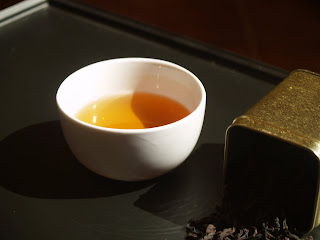It is adapted from the manual of the Specialty Tea Institute's (STI) pu'erh tea course.
"All types of pu'erh tea start with maocha, meaning 'rough tea'. The preparation of maocha is as follows;
-The tea leaves are plucked and then taken to a central factory.
-Leaves are screened for stems and leaves of bad quality, which are thrown out.
-The leaves are then withered to reduce the moisture content and make them pliable.
-Leaves are then rolled to break the cell walls.
-The leaves are then set out to dry until the moisture remaining is about 10%.
-Leaves are then rolled again, and then a final sorting takes place.
The finished product is then sold, usually by auction, to factories and small production facilities. The maocha can either be used to make sheng cha (uncooked, raw), or shu cha (ripe, cooked).
We will focus on shu cha.
In 1972, the Yunnan Kunming Tea Company implemented a process they dubbed 'Wo Dui.'
The process was developed after an increase in the popularity of aged pu'erh teas. Usually sheng cha would take about 10 years to reach what was known as maturity. The flavors were said to be well rounded and mellowed out.
The Wo Dui process is meant to replicate 10 years of aging in a matter of months.
The process is explained;
Maocha is moistened with water and then piled up in an environment where heat and moisture levels are meticulously monitored and controlled. The pile of leaves begins to heat up through a process much like that of a compost pile. The leaves are turned as needed to ensure that the oxygen, moisture and microbial levels (microbes are essential for breaking down the leaves and help for decomposing them) are consistently maintained to even out the process throughout the pile. The process is a sped up fermentation of the leaves that gives them its dark, rich color. The entire process is a closely guarded secret, so the aforementioned description is very general."
The description of the pu'erh is a mix of my comments as well as some from the STI manual. It would take too long to distinguish between the two, so I put all of it in quotes. I hope you learned something.
Now onto the tea.
This tea is from the Still Mountain tea shop in Nevada City, CA.
It is labeled as an Ancient Tea Tree production.
By my observation I would say that it is definitely a shu cha, but I cannot say for sure how old it is.
The tea itself is very tippy (the gold color sprinkled throughout the tou).
It smells strongly of mushroom with a pumpkin spice / sweetness.
 The aroma of the liquor is reminiscent of damp soil and coffee beans.
The aroma of the liquor is reminiscent of damp soil and coffee beans.A caramel sweetness is the first note detected, probably due to the amount of tips.
The mouth feel is lighter than expected.
As the liquor cools, mahogany tones present themselves along side a salty note.
 In the following infusions, heavy wood notes are revealed, along with leather and a bit of a charcoal taste (maybe due to an over firing..?). But the charcoal taste was very faint so maybe it is just my taste buds.
In the following infusions, heavy wood notes are revealed, along with leather and a bit of a charcoal taste (maybe due to an over firing..?). But the charcoal taste was very faint so maybe it is just my taste buds.In the last infusions, a very nice sweetness emerges and is a good finish for the tea session.
 The leaves are quite chopped, as you can see, which made me keep my infusion times very short. This tea would have been easy to over steep.
The leaves are quite chopped, as you can see, which made me keep my infusion times very short. This tea would have been easy to over steep.I enjoyed it though. I find that shu pu'erh is sort of like comfort food. There is not too much variety, but it is a familiar taste that is sometimes a craving.
A thank you to my Aunt for hunting down these teas for me.
~billy


































